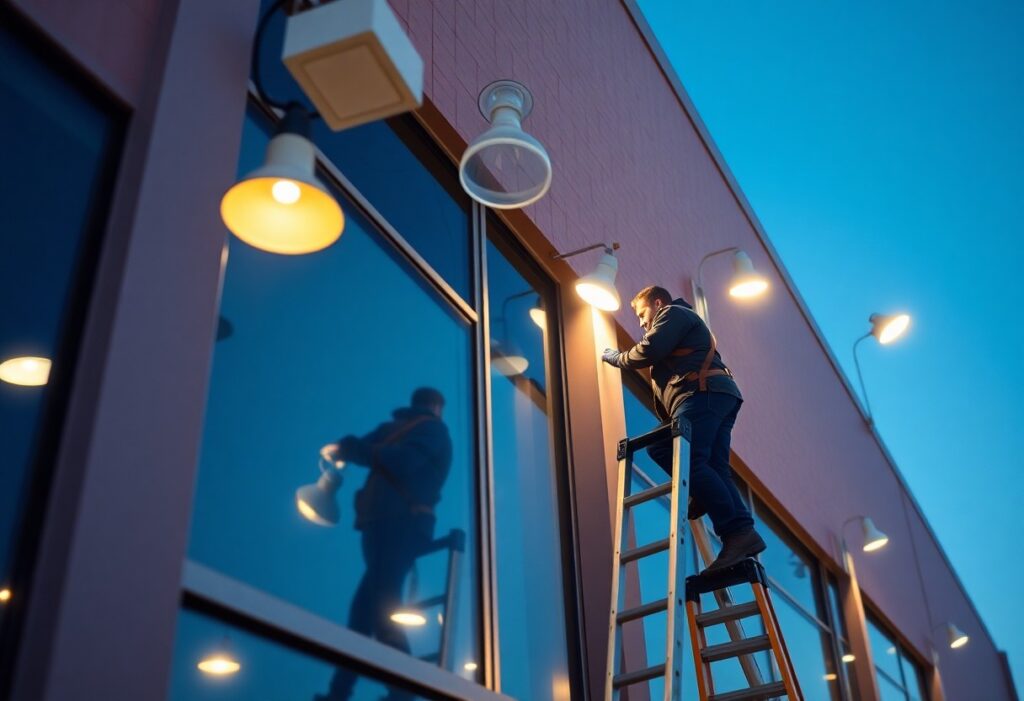It’s important for property managers like you to stay informed about the benefits and intricacies of LED retrofit projects. Transitioning to LED lighting not only enhances energy efficiency but also reduces long-term operating costs for your properties. This blog post will guide you through key considerations, best practices, and potential challenges you may encounter during the retrofit process. By understanding these factors, you can make informed decisions that will improve your property’s sustainability and appeal.
Key Takeaways:
- Assess the current lighting infrastructure and identify areas where LED retrofitting can yield the highest energy savings and efficiency improvements.
- Understand the financial incentives available, such as rebates and tax credits, which can significantly offset the upfront costs of LED retrofitting.
- Plan for potential challenges, including installation timelines and potential disruptions to tenants, ensuring effective communication throughout the process.
Understanding LED Retrofit Projects
For property managers considering energy-efficient improvements, understanding LED retrofit projects is crucial. These projects involve replacing traditional lighting systems with LED lighting, optimizing energy consumption while achieving better illumination quality. To learn more about such endeavors, check out The Ultimate Guide To Commercial Retrofit Lights.
Definition of LED Retrofit
To put it simply, an LED retrofit is the process of upgrading existing lighting fixtures with LED technology. This can involve replacing the entire fixture or only the light source while maintaining the existing housing. The goal is to enhance energy efficiency and extend the lifespan of your lighting system.
Benefits of LED Retrofit Projects
Beside reducing energy costs, LED retrofits offer numerous benefits that can significantly impact your property’s operational efficiency. These projects not only lower energy consumption but also reduce maintenance needs and carbon footprint while providing superior lighting quality.
Another key advantage of LED retrofit projects is the potential for substantial cost savings over time. With longer lifespans and decreased energy requirements, you will find fewer replacements and lower electricity bills, enhancing your budget flexibility. Additionally, many municipalities and utility companies offer incentives or rebates for implementing energy-saving lighting solutions, further enhancing the financial appeal of your retrofit project.
Common Misconceptions
At times, misconceptions about LED retrofits can lead to hesitation in adopting this technology. Some property managers may believe that LED lights are too expensive upfront or that they require extensive changes to existing wiring and fixtures.
Energy efficiency is often misunderstood. Initially, while the cost of LED fixtures may seem higher than traditional options, the long-term savings in energy costs and maintenance can greatly outweigh the initial investment. Moreover, retrofitting typically requires minimal adjustments to your existing system, making it a straightforward process that doesn’t disrupt operations significantly.
Assessing Current Lighting Systems
To begin your LED retrofit project, it’s vital to evaluate the current lighting systems in place. By assessing your existing infrastructure, you can clearly determine which areas need enhancement, thereby leading to informed decisions that align with both efficiency and cost-effectiveness.
Importance of a Lighting Audit
About conducting a lighting audit is crucial for understanding not just how much energy your current system consumes, but also its effectiveness in illuminating your property. This systematic review allows you to pinpoint areas where lighting may be inadequate or inefficient, setting the stage for a successful upgrade.
Identifying Areas for Improvement
Any assessment should focus on finding potential areas where your lighting solutions can be optimized, which may include insufficient brightness, uneven distribution, or unnecessary energy expenditure. Recognizing these weaknesses will empower you to design a more efficient lighting plan tailored to your property’s specific needs.
Lighting plays a significant role in both aesthetics and functionality. By focusing on the areas that require improvement, you not only enhance the overall atmosphere of your property but also reduce energy costs and increase tenant satisfaction. Regular evaluations can help you stay ahead of any problems and maintain an inviting and efficient environment.
Evaluating Existing Fixtures
Importance lies in reviewing your existing fixtures to determine their compatibility with LED technology. By examining their condition, type, and suitability for retrofitting, you can identify which fixtures can be upgraded and which may require complete replacement.
In addition, understanding your current fixtures enables you to enhance energy efficiency and lighting quality. This evaluation will let you decide whether to implement retrofits or explore entirely new installations, ultimately aiding you in achieving your sustainability goals while minimizing installation costs.

Planning the Retrofit Strategy
Unlike traditional lighting upgrades, an LED retrofit project requires meticulous planning to ensure a smooth transition and maximum benefit. By following a strategic approach, you can optimize your investment and enhance property management efficiency.
Setting Goals for the Retrofit Project
Behind every successful retrofit project lies a clear set of goals. You should define what you aim to achieve, whether it’s reducing energy consumption, lowering maintenance costs, or improving tenant satisfaction. Establishing measurable objectives will guide your project and help you assess its effectiveness.
Budgeting for the Project
Retrofit projects can require substantial initial funding, but they often lead to significant long-term savings. You will need to calculate the costs of new LED products, installation, and any potential upgrades to your electrical systems. This budget will serve as the framework for your project’s financial viability.
Budgeting involves considering both direct expenses, like purchasing LEDs and hiring contractors, and indirect costs associated with potential disruptions during installation. It’s wise to include a contingency fund for unexpected expenses to ensure your retrofit stays on track financially.
Choosing the Right LED Products
By selecting the appropriate LED products, you ensure they meet your property’s specific lighting needs. Review options that align with your goals, and consider factors such as brightness, color temperature, and energy efficiency ratings to optimize performance.
To select the best LED products, research manufacturer specifications and consult with experts to ensure compatibility with your existing fixtures. Prioritize quality and warranties, as investing in reliable products can provide better returns in energy savings and longevity.
| Key Considerations | Description |
|---|---|
| Goals | Define measurable objectives for energy savings and tenant satisfaction. |
| Budgeting | Calculate costs, including direct and indirect expenses, and set a contingency fund. |
| LED Products | Select high-quality LEDs that meet performance needs and warranty requirements. |
Implementation Process
Many property managers find that the implementation process is where the true benefits of an LED retrofit project come to life. You should be aware of the steps involved, from selecting the right products to scheduling installations. For helpful insights, you might want to Consider an LED Lighting Retrofit as you move forward with your project.
Hiring Professional Contractors
An effective retrofit requires skilled professionals who understand LED technology and installation requirements. You should research and select contractors who have experience with similar projects and can provide references. Ensure they understand your specific needs and can deliver a reliable, energy-efficient solution.
Project Timeline Considerations
Across various projects, timelines can vary significantly based on factors such as the scope of work and the number of fixtures to be replaced. Planning is crucial to minimize disruptions in your property.
Professional contractors will help you develop a realistic timeline that accounts for equipment delivery, installation durations, and any necessary inspections. Conducting pre-installation meetings can further streamline the process and ensure everyone is aligned on expectations and deadlines.
Safety Protocols During Installation
At every stage of the installation, safety should be a top priority for both staff and residents. You need to ensure that all contractors adhere to safety guidelines to prevent accidents or disruptions.
Implementation of proper safety protocols involves maintaining clean work areas, using appropriate personal protective equipment, and ensuring that all work is completed following industry standards. You should communicate with contractors about scheduled times for work to keep your property occupants informed and safe during the installation process.
Post-Retrofit Considerations
Despite the advantages that come with LED retrofit projects, there are vital considerations to keep in mind post-installation. Addressing issues such as maintenance, monitoring energy savings, and educating tenants about the changes can ensure that your investment achieves its full potential. For a more detailed understanding, you can refer to Property Management and LED Lighting: Cost-Benefit Analysis.
Maintenance of LED Lighting
Across your property, the efficient performance of LED lighting requires regular maintenance. Although LEDs generally require less upkeep than traditional lighting, you should establish a schedule for inspections and cleaning to prolong their lifespan and efficiency.
Monitoring Energy Savings
On the other hand, tracking the energy savings achieved through your retrofit is critical for maximizing returns. Utilizing monitoring tools can help you assess energy consumption trends and ensure that the expected reductions in utility costs are being realized.
In fact, implementing real-time energy monitoring systems can provide you with valuable insights into your building’s performance. This data allows you to identify areas where further optimization can take place and can also assist in planning future upgrades, ultimately enhancing the overall efficiency of your property.
Tenant Education on New Lighting
Around your buildings, it’s important to communicate changes to your tenants effectively. Familiarizing them with the benefits of LED lighting can enhance their experience and ensure they understand how to properly utilize the new fixtures.
With proper education, tenants are more likely to appreciate the improved lighting quality and energy efficiency, which can lead to higher satisfaction levels. Consider hosting informational sessions or providing resources that highlight the operational differences and benefits they can expect with the new lighting system. This engagement not only fosters goodwill but can also promote responsible energy usage within your premises.
Financial Incentives and Rebates
Understanding Available Incentives
Your decision to retrofit LED lighting can lead to significant cost savings, and understanding the available financial incentives can enhance your budget. Many local, state, and federal programs exist to support your transition to energy-efficient solutions, making it easier for your property to benefit from reduced energy consumption and lower operating costs.
Navigating Utility Rebates
Along with direct incentives, utility companies often provide rebates for LED retrofits, which can significantly reduce your upfront costs. Each utility provider has its own set of guidelines, eligibility criteria, and application processes for these rebates.
In addition to regular rebates, many utility companies run special promotions or limited-time offers that can further enhance savings. It’s important to contact your local utility provider to inquire about their specific rebate programs, as these offerings can change frequently. Staying informed about deadlines and requirements ensures you don’t miss out on valuable opportunities that could financially benefit your retrofit project.
Federal and State Financial Programs
Federal programs, along with various state initiatives, provide additional financial support for LED retrofit projects, allowing you to capitalize on tax incentives and grants. These programs are designed to stimulate energy efficiency across the country, benefiting not only property managers but the environment as a whole.
And, engaging with these financial programs can be highly beneficial as they often include favorable financing terms or tax deductions that allow you to expand your investment in energy-efficient upgrades. By familiarizing yourself with both federal and state options, you can maximize potential savings, ensuring a more impactful and sustainable renovation for your properties.
Final Words
With these considerations in mind, you are better equipped to navigate LED retrofit projects for your properties. Understanding the technological benefits, financial incentives, and installation processes will help you make informed decisions that enhance energy efficiency and reduce costs over time. Engaging with qualified professionals and conducting thorough assessments will ensure that your transition to LED lighting meets both your property management goals and tenant satisfaction. Embracing this upgrade is not only a smart investment but also a step towards sustainability in property management.
FAQ
Q: What are LED retrofit projects and why should property managers consider them?
A: LED retrofit projects involve replacing existing lighting fixtures with energy-efficient LED options. Property managers should consider these projects to reduce energy consumption and utility costs, enhance the quality of lighting, and decrease maintenance expenses due to the longer lifespan of LED bulbs. Additionally, moving towards eco-friendly solutions aligns with sustainability goals and can improve tenant satisfaction with well-lit spaces.
Q: What factors should be evaluated when planning a LED retrofit project?
A: When planning an LED retrofit project, property managers should assess factors such as the current lighting infrastructure, the types of fixtures in place, and the specific needs of the property. Budget considerations are also important, as well as calculating the potential return on investment (ROI) from energy savings. Additionally, it’s wise to consider local incentives or rebates for energy-efficient upgrades that could offset project costs.
Q: How can property managers ensure a successful LED retrofit project?
A: To ensure a successful LED retrofit project, property managers should engage reliable contractors with experience in energy-efficient upgrades. It’s also important to plan for minimal disruption to tenants during the installation process. Conducting a thorough assessment of existing electrical systems and involving stakeholders, such as building engineers or energy auditors, can lead to better outcomes. Finally, ongoing maintenance and monitoring of the new lighting system are vital to maximize its benefits and efficiency.



